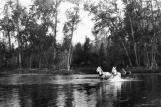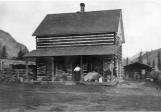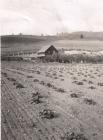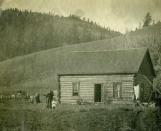6
Crossing the Kettle River at Bubar Ford; bridges were few and far betweenCirca 1900
The Kettle River Valley
 Credits:
Credits:Kettle River Museum
Bubar family photograph
7
Following fencelines along the valleyCirca 1910
The Kettle River Valley
 Credits:
Credits:Kettle River Museum
Donated by Nora Eveleth, 1978
8
Jackson Ranch"...a suitable ranch was then bought at the mouth of Myers Creek. This ranch had a large timbered flat with a big creek suitable for irrigation.
In the spring of 1890 father returned to Kamloops and on June 25th married Miss Agnes B. Tannahill, a native of Scotland. After purchasing a team, wagon and other necessary equipment for their new home, they proceeded to Mission (now Kelowna) where everything but the horses were loaded on an Indian scow to be transported down the Okanagan Lake. Father and Mother rode the horses down the east side of the lake and met up with the Indians and their wagon at what is now the city of Penticton.
They loaded their wagon and headed south through the Okanagan Valley to what is now the village of Osoyoos. Here it was necessary to ford the lake at that narrow neck of land, proceed over the Anarchist Mountain to the Kettle River valley. They reached their new location after traveling many miles over bad roads, trails and numerous swollen streams. In spite of all the hardships these hardy pioneers developed a fine ranch which is still in the family, presently being operated by the youngest son, Robert."
- from "John Robert Jackson", contributed by the Jackson Family, Boundary Historical Society 4th Report, 1968
9
The J.R. Jackson Ranch on the Kettle River just west of Midway1910
The Kettle River Valley
 Credits:
Credits:Kettle River Museum, Sonny Jackson collection
Donated by the estate of Mike Downing, 1977
10
Into the benchlands above the Kettle River1900-1910
Benchlands of the Kettle River Valley
 Credits:
Credits:Kettle River Museum
Donated by Nora Eveleth, 1978
11
View of the Hopper Ranch on Ingram MountainCirca 1910
Benchlands of the Kettle River Valley
 Credits:
Credits:Kettle River Museum
Donated by Fred Lander, 1977
12
Sidley's Ranch"From its first small beginnings, Mr. Sidley's ranch has gradually been increased in size until today its area is about 2,000 acres, including arable land equal to any in the district, pasture lands, and some fine timber country, upon which fir, pine and tamarack, much of this timber suitable for saw logs, are to be found in abundance. The timbered lands are generally of good soil, having open stretches of up to 50 acres each among the belts of trees, making them well-suited for dairying, especially as numerous springs provide plenty of water. In the neighbourhood are ranges fit for either sheep or cattle, so that either dairying or raising cattle or sheep for the butcher can be followed to advantage, specially now that markets are becoming easily accessible. Heretofore, outside of a small market at Camp McKinney and Midway, there has been little demand for dairy produce, but this drawback is being removed as the mining towns and camps of the Boundary increase in population and provide a market for these and other products.
...This land is under cultivation this season for the first time, and oats and barley sown on the sod have grown and yielded so well that its fertility was evident to all who saw the crops growing. Mr. Sidley had under cultivation this year about 400 acres, of which 150 acres were in grain, 12 acres in roots, and the remainder fallow for next season's cropping. These fields are all fenced, as too is all the rest of the ranch upon which there are in all about 10 miles of rail fencing."
- from "R.G.Sidley's Ranch", the Midway Dispatch, September 29, 1902.
13
The Bodman Place on Rock MountainCirca 1910
Benchlands of the Kettle River Valley
 Credits:
Credits:Kettle River Museum
Donated by Mary Rock, 1978
14
A Kettle River Valley homestead in the early days1900
The Kettle River Valley
 Credits:
Credits:Kettle River Museum
Donated by Nora Eveleth, 1978
15
A Girl's Memories of Homesteading"I was to go over to Rock Creek. Susan, my sister of seven, was to come with me. Our bedroll and small valise were soon stowed away on the top of the pack and off we went without a glance back to mother and Irene who waved us goodbye. We passed the stable, corrals, the cabins and through the bars into the beloved Aspen Grove Pasture where we had so often played, and past two graves, with white picket fences - my father and a little baby sister lay there.
A few days before, mother had sent Irene and me up to Frank Richter's with a note asking if she could rent the Nicholson place at Rock Creek. Having obtained permission, I was to go over and make the cabin habitable for mother.
On we went and eventually came to the crossing of Rock Creek, a steep zigzag trail that led down to the Creek, and a steep trail down to Harry Pittendrigh's stopping place on the Kettle River. He directed us to the cabin on the hill where he and his wife Bessie lived. Tho' we had never met she was glad to have Susan and me come to stay.
Next afternoon, with Bessie to show us the way, we forded the river just south of the hotel, and rode the three and a half miles to the Nicholson cabin, on the Creek. "There is your future home," said Bessie. It was a forlorn, forsaken, double cabin. A dirt roof extended across the two with a breezeway between. The back half was boarded across to serve as a kitchen. Windows were broken, doors off. Cattle and horses had used it as a shelter from the flies and winter snow. We did not dismount but I turned away with deep troubled thoughts. What a place to come live in..."
- from "Rock Creek - 1895" by Hester E. White, Boundary Historical Society 3rd Report, 1960
16
The marriage of Bevan and Constance GaneAugust 1913
Benchlands of the Kettle River Valley
 Credits:
Credits:Kettle River Museum
Courtesy of the Gane Family
17
In the early years many of the farms were occupied by bachelors who did their own cooking and washing besides the farm work. These men were young when they arrived in this western country, some of them having crossed a continent to get there. They worked hard at farming and various occupations; they had to, to survive.As years went on, dwellings were improved upon, especially when a man was lucky enough to marry a good partner to share his life. Although farm work entailed long hours and plenty of footslogging there was never a shortage of good things to eat or wood to keep the home fires burning and provide comfort after the day's work was done.
- from "A Harvest of Memories" by Bill Hatton, 1985
18
John Walker's meadow and hen house at Myers CreekCirca 1910
Tributaries of the Kettle River
 Credits:
Credits:Kettle River Museum
Donated by Alf Maletta, 1981
19
The construction of the Canadian Pacific Railway in to Midway around the turn of the century followed by the Great Northern Railway a few years later meant a lot of activity to the district. There was considerable rivalry between the two railroads, and during construction of the Great Northern between Midway and Oroville a small war was waged with the CPR over right-of-way through our property. The contractors on each side had teams of horses pulling away the steel as fast as it was laid! However, the Great Northern won out and continued the construction on to Oroville...- from "John Robert Jackson", contributed by the Jackson Family, Boundary Historical Society 4th Report, 1968